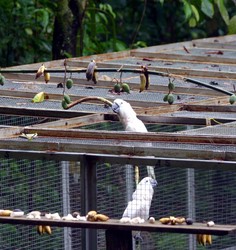
| Amazon Expedition Travel
|
 |
|
|
|

| User Functions
|
|
|
Don't have an account yet? Sign up as a New User
|
|

| Help support this site!
|
|
|
Help support this site... your donations are needed to support research, conservation, and rescue efforts.
|
|

|
 |
| 16 Seram (Moluccan) Cockatoos and 4 Purple-Naped Lories Released Back to the Wild |
 |
Thursday, April 17 2008 @ 07:54 PM UTC
Contributed by: MikeSchindlinger
Views: 6845
|

 April 9, 2008 -- The illegal wild bird trade remains rampant in Indonesia, and includes a number of parrot species; populations of some of these are considered vulnerable to future extinction. April 9, 2008 -- The illegal wild bird trade remains rampant in Indonesia, and includes a number of parrot species; populations of some of these are considered vulnerable to future extinction.
Enforcement of laws protecting parrots is critical, and such interdiction has recently been stepped up in Central Maluku by officers ofBKSDA (Conservation and Natural Resources) and the Department of Forestry.However, the problem then remains as to the disposition of birds captured by government authorities.
Some of these birds cannot be returned to the wild for various reasons, but a select sub-population can be released if they meet criteria set forth by IUCN (the World Conservation Union) and CITES (Convention on the Trade in Endangered Species). The Indonesian Parrot Project has now carried out three such parrot releases.
The illegalwild bird trade remains rampant in Indonesia, and includes a number of parrot species; populations of some of these are considered vulnerable to future extinction. Enforcement of laws protecting parrots is critical, and such interdiction has recently been stepped up in Central Maluku by officers of BKSDA (Conservation and Natural Resources) and the Department of Forestry.However, the problem then remains as to the disposition of birds captured by government authorities. To begin to address that problem, the Indonesian Parrot Project established the Kembali Bebas Rehabilitation Center on North Seram Island to receive such parrots; the Center is managed by Yayasan Wallacea(director, Ceisar Riupassa). The day-to-day care of the parrots is provided by former bird trappers and consequently, poaching of parrots on this circumscribed part of the island has been virtually eliminated.
Some of these birds cannot be returned to the wild for various reasons, but a select sub-population can be released if they meet criteria set forth by IUCN(the World Conservation Union) and CITES (Convention on the Trade in Endangered Species). The Indonesian Parrot Project has now carried out three such releases.
The first occurred in March, 2006, and involved three Seram cockatoos (Cacatua moluccensis) which had been confiscated in October of 2004 by the Department of Forestry. Birds were micro-chipped, given stainless steel leg bands, and their tails were colored to facilitate visual monitoring. The cockatoos were screened for the presence of latent avian diseases by PCR, as well as hemagglutintion-based methodologies on samples sent to collaborators in the United States and Australia. The procedure was a "soft release", wherein birds are permitted to leave the habituation cage of their own volition and at their own pace; food is provided at the release site for two weeks as a supplement in case the cockatoos are unable to forage successfully.
Following this first release, one cockatoo was seen flying well for several weeks, and then was lost to follow-up. The other two have been spotted over a period of at least 12 months. In March-April, 2007, at least one of the remaining two cockatoos produced a successful fledging. In August of 2007, at least one of these two could be identified in a pair of cockatoos examining potential nest sites close to Kembali Bebas.
In January, 2008, an additional 6 Seram cockatoos were released, also with apparent very-short-term success. These birds had been confiscated from smugglers in the town of Tanah Merah on Seram, having never left the island;the confiscation (like the one resulting in the 2006 release) was made possible due to information provided by a local informant.
For the first time, testing for latent avian diseases was carried out in Indonesia in the laboratory of Dr. Ngurah Mahardika, Udayana University-Bali,working in collaboration with Drh. Wita Wahyudi, Director of the Wild Animal Rescue Center in Bali. The release site this time was not within the confines of the Rehabilitation Center, but rather the newly-constructed Forestry station in Manusela National Park.
In February of 2008, an additional 7 Seram cockatoos and 4 Purple-naped lories(Lorius domicella) were likewise released, bringing the total to-date to 16cockatoos and 4 lories. The children of nearby villages were able to witness these releases and share in the excitement.
Although this number of birds by itself is not large, such releases offer a significant opportunity to increase the pride of local villages and children in their native birds, and to teach by example the principles of conservation. Furthermore, it is hoped that similar stringent selection and release procedures will become the standardized norm for parrots throughout the Indonesian archipelago.
http://www.prweb.com/releases/2008/04/prweb842734.htm
|
|
|
|

|

|

